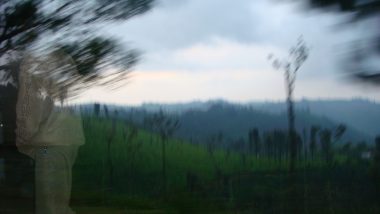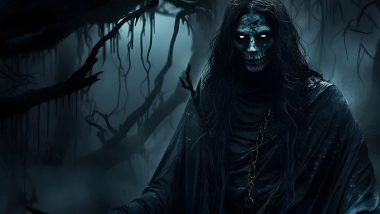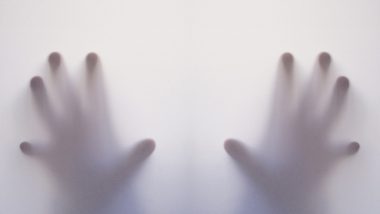Bhoot Chaturdashi, a festival steeped in the supernatural, celebrates the spirits or "bhoots" that permeate Bengali folklore. In Bengal, ghosts are not merely figments of fear; they reflect the rich tapestry of cultural experiences and societal structures unique to the region. Unlike ghosts in many other cultures that haunt domestic spaces, Bengali spirits often inhabit the marshes, ponds, and forests, and some possess the ability to take human form. The characteristics and stories surrounding these ghosts reveal deep-seated beliefs and traditions that continue to captivate the imagination. Ghosts on a Plane? Scared Passengers Capture Floating Spirits at Nearly Empty Airport in Phuket, Old Video Resurfaces Online Ahead of Halloween 2024.
Characteristics of Bengali Ghosts
Bengali ghosts are often identifiable by a peculiar method: if you hold a lit turmeric root under their nose, they cannot tolerate the smell. Known for their insatiable appetites, particularly for fish—a staple in coastal Bengal—these spirits can be mischievous or even vindictive. Here, we explore some of the most notable ghosts from Bengali folklore.
Brahmadaitya
The Brahmadaitya are the spirits of deceased Brahmins, belonging to the highest caste in Hindu society. According to legend, if a Brahmin boy dies within ten days of undergoing the poite ceremony—marking his transition into Brahminhood—he becomes a Brahmadaitya. These spirits reside in the sacred peepal tree, which symbolizes three principal deities: Brahma, Vishnu, and Shiva. While Brahmadaityas generally do not seek to frighten humans, they can become enraged if their dignity is insulted. As 19th-century folklorist Lal Behari Day noted, their wrath can be severe, often leading to violent retribution.
Petni
Petnis are the restless spirits of unmarried women who passed away with unresolved desires. They resemble living women but have one distinguishing feature: their feet point backwards. Traditionally, petnis were seen as terrifying figures, known for their violent tendencies when wronged. However, modern interpretations often view them sympathetically as embodiments of female desire that challenge patriarchal norms. Renowned Bengali writer Rabindranath Tagore incorporated female ghosts in his works to highlight women's struggles and give them the agency they lacked in life. When Is Bhoot Chaturdashi 2024? Know Kali Chaudas Date, Puja Timings, Muhurat, Rituals and Significance To Observe the Day on the Eve of Kali Pujo.
Sankhachurnis
The Sankhachurnis, or Sankchinnis, are the spirits of married women and widows, identifiable by their white garments resembling conch shells. These ghosts are less aggressive than petnis but can easily take offense. They often seek to possess married women to relive their own domestic experiences. One popular tale illustrates this: a woman inadvertently brushes against a Sankhachurni, provoking her wrath. The ghost then imprisons the woman in a tree and takes her place in the household, initially impressing the family with her apparent skills. However, her strange behaviour eventually reveals her true identity, leading to a dramatic confrontation.
Mecho Bhoots
Mecho bhoots are male spirits, typically fishermen or individuals who drowned. Known for their love of fish, these ghosts haunt lakes and ponds in search of their favourite meal. Unlike many other Bengali spirits, mecho bhoots are not inherently malevolent. Instead, they often beg travellers or fishermen for fish, using a nasal tone to plead, "Machh diye ja" (give me the fish). Their presence can be both humorous and eerie as they glide through the waters, seeking sustenance.
Skondhokatas
The Skondhokatas are headless spirits, their origins evolving over the years. In the 19th century, they were depicted as vengeful entities who would attack or enslave the living in search of their lost heads. They are said to roam low-lying areas and bogs, often appearing in the dark. Their haunting nature and tragic backstories add depth to their spectral persona.
Aleya
The Aleya are ethereal orbs of light seen over marshes, believed to be the souls of dead fishermen. While these flickering lights can sometimes lead unsuspecting fishermen to their demise, they can also guide travellers safely. The legends of aleya primarily originate from the Sundarbans, a vast region of tidal islands, marshes, and mangrove swamps in West Bengal, considered one of the most haunted areas in the state.
Nishi Dak
Finally, the Nishi Dak are the shadows of individuals denied a proper burial. They are known for their eerie ability to mimic the voices of loved ones, luring victims into secluded areas before revealing their true forms. Interestingly, there’s a way to discern a Nishi Dak’s call: they can only utter a name twice. If a person hears their name called three times, it indicates that they are safe and not being haunted by a ghost.
Bhoot Chaturdashi brings to life the diverse and rich folklore of Bengali ghosts, illustrating a cultural reverence for the supernatural. These tales not only reflect the fears and beliefs of the people but also serve as a means to understand societal norms and the struggles faced by various groups, particularly women. As these stories continue to be told and retold, they preserve the legacy of a vibrant cultural heritage, ensuring that the ghosts of Bengali folklore remain a captivating part of the region’s identity.
(The above story first appeared on LatestLY on Oct 28, 2024 12:15 PM IST. For more news and updates on politics, world, sports, entertainment and lifestyle, log on to our website latestly.com).













 Quickly
Quickly





















